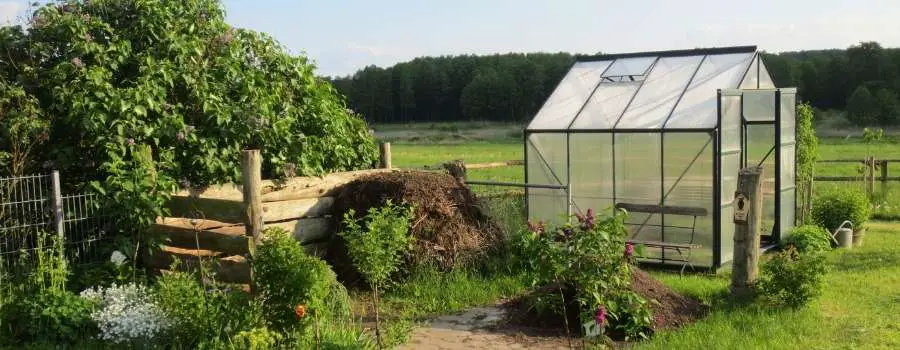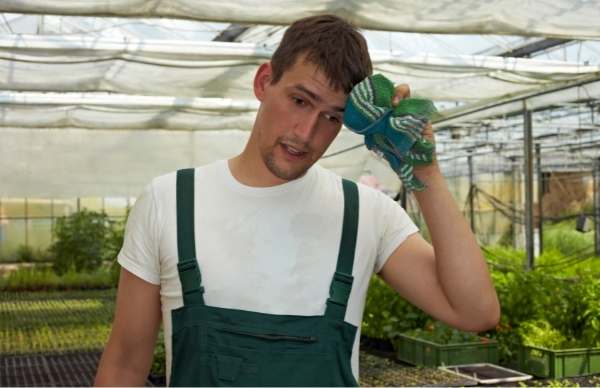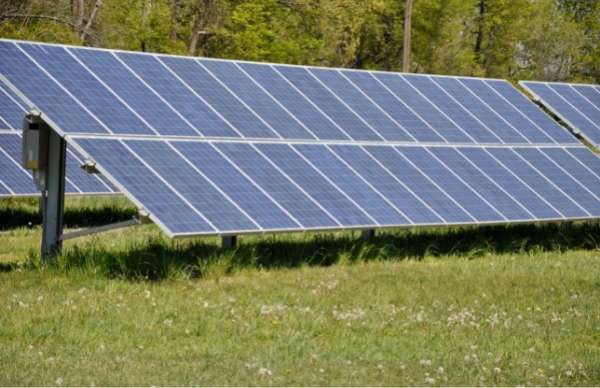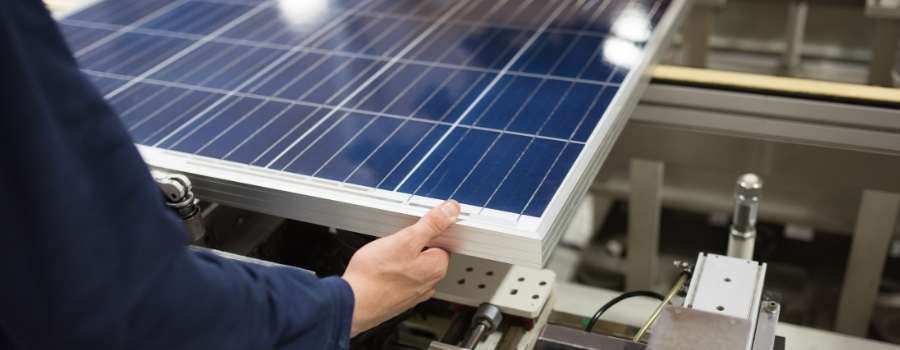Both home gardeners and commercial-scale farmers are beginning to realize the benefits of using solar power in their operations. Many eco-friendly gardeners already use solar panels to provide energy for their homes–but can solar power be used to power a greenhouse?
In general, you can put solar panels on a greenhouse. While there are special greenhouse solar panels that can be mounted on the top of the greenhouse, any solar panels can help a greenhouse become energy-neutral.

Can You Put Solar Panels On A Greenhouse?
Solar panels can be installed on greenhouses or mounted near them in order to provide lighting, watering systems, or heating. In fact, solar panels are helping to solve environmental problems with greenhouse growth as it helps curb some of the power usages of heat lamps as well as other reasons.
Around the world, greenhouse gardening is becoming more and more popular, especially amongst people who want a taste of self-sufficient living without fully going “off the grid.”
Since they are temperature-controlled, greenhouses lengthen the growing season. Greenhouse gardens also need less water, pesticides, and fertilizers.
However, one big drawback to greenhouse gardening is the cost of powering greenhouses. Using traditional electricity to power a greenhouse seems to eliminate the environmental benefits of growing plants indoors. Studies have also shown that growing in greenhouses can increase energy costs when compared to growing outdoors in traditional settings.
Tthankfully, advancements in solar panel technology have created a more efficient, cost-effective way to power greenhouses. Heating a greenhouse is one of the most costly parts of growing indoors; without proper temperature control, plants may fail to thrive or even go into shock and die.
Solar panels capture energy from the sun and turn it into electricity, which can then be utilized by electric heaters. The power generated by solar panels can also power any other electronics in the greenhouse, such as timers, airflow vent systems, and lights.

How Do You Heat A Greenhouse With Solar Panels?
Similar to a home solar array, greenhouses can be heated with solar by using solar panels that are hooked to a solar inverter which is connected to a climate control system. Solar batteries will hold power collected during the day so that it can be used through the night, keeping your greenhouse at a consistent, pre-set temperature 24 hours a day.
Solar panels can be used to efficiently heat a greenhouse, though the process is a bit complicated. With regular electricity, a heater can be plugged right into the wall. However, with solar panels, the electricity needs to be transformed into the proper current before it can be used.
To solve this problem, many people charge a battery with their solar panel, then use a power inverter to transform the electricity from DC to AC, which can then power the heater.
Be sure you don’t forget to buy batteries and an inverter when you’re getting ready to use solar panels to heat your greenhouse. Without these, you’ll have built up solar energy and no way to use it.
Thankfully, manufacturers have made things easier by designing and selling solar-powered greenhouse kits. These kits make setting up solar power in your greenhouse much simpler.
Though setting up a battery and inverter system may seem complex, it won’t need much upkeep once it’s set correctly. Hiring a professional solar installer is a great way to ensure the job is completed correctly so you can relax and enjoy your new eco-friendly greenhouse.
How Many Solar Panels Do I Need To Heat My Greenhouse?
Generally, you will want 8 solar panels per 1000 square feet of greenhouse you wish to heat or power. Of course, what you are growing, the general climate of your area, and what systems you plan to power with solar will require more or fewer panels.
That’s the general answer, but let’s get a little more…mathy (just a little.) A photovoltaic solar panel system will generate anywhere from 10 to 35 kWh per square foot per year; each square foot of a greenhouse will require 1kWh of energy per year.
If that sounds too complicated, let’s use a 10,000-square-foot greenhouse as an example. After doing some calculations, we can see that this 10,000 square foot greenhouse will need approximately 27 solar panels that measure 3 feet by 5 feet.
Of course, many home gardeners won’t have a greenhouse nearly this large, so the required number of solar panels will be smaller. Still, to effectively warm a greenhouse in sub-zero temperatures, many solar panels are needed.
If you’re exclusively using solar panels to heat your greenhouse, it’s important to buy a few backup panels. The last thing you want in the dead of winter is to have your solar panels stop functioning! To keep your plants safe and sound, always have extra solar panels and charged batteries ready to go in case something breaks.
Are There Other Options For Solar Powered Heat In Greenhouses?
While solar panels are a good option for heating your greenhouse, there are other solar options available. These options might be the right choice for your greenhouse if cost is a concern, as solar panels are a very costly investment.
The transparent siding and roofing on a greenhouse capture a significant amount of sunlight and heat each day. However, greenhouses are notorious for their lack of ability to keep this heat contained. In fact, most greenhouses retain about 10% as much heat as the house does, making them terribly inefficient.
Adding passive solar devices to your greenhouse can significantly improve the amount of heat retained. Brick pavers, barrels of water, and heavier insulation in walls are all passive solar devices.
These devices capture heat from the sun during the day, then slowly release it overnight. Because you can find many of these devices around your property or purchase them at a low price, passive solar heating is very cost-effective.
However, the biggest drawback of solely using passive solar heating in your greenhouse is the lack of electricity made available. If you have electric vents or fans in your greenhouse, you’ll be forced to plug them into the wall instead of powering them with solar panels.
Another issue with passive solar heating is that it’s difficult to maintain an exact temperature in the greenhouse. While the passive solar devices will heat the greenhouse consistently, the temperature will be nearly impossible to change manually. Having an electric heater as a backup can solve this issue.

For Greenhouses, Is It Better To Ground Mount Solar Panels?
Since the plants in your greenhouse rely on the sun just as much as your solar panels, you will want to mount your solar array on the ground if possible. Doing so means that both your plants and your solar panels will receive maximum sunlight throughout the day.
Plants in greenhouses receive sunlight through the roof of the greenhouse. This means that the roof must stay clear of any light-blocking surfaces, such as normal photovoltaic solar panels.
If you put solar panels on the roof of your greenhouse, you’ll be forced to supplement light to your plants, which destroys much of the purpose of the greenhouse. Instead, you should mount your solar panels on the ground.
When mounting your panels on the ground, you will still want them elevated and set at an angle that receives the most sunlight throughout the day. Some solar arrays can be set onto motorized mounts which allows you to program them to follow the direction of the sun throughout the day.
While these motorized mounts are nice, people with a home-based greenhouse can get all the power that they need with static mount solar panels…just make sure you note where the sun is at during mid-day and point your panels in that direction.
A Little More Information About Ground Mounting Solar Panels
Before you order ground-mounted solar panels, there are a few things to note about this style of solar panel installation.
- They are typically more expensive – Because ground mounted solar panels require extra equipment–such as cement foundations and pole structures–they will cost you extra. The added labor cost will add a significant chunk to your bill as well.
- They may struggle with pest issues – Because the solar panels will be at ground-level, the wiring will be easilyaccessible to rodents and pests. You’ll need to watch your solar wiring systems to make sure they aren’t being destroyed by small critters. Some solar companies will dig trenches and bury the wires under the ground, which is another added cost.
- They need adequate space to operate correctly – One of the nice things about solar panels mounted on a roof is they typically have uninterrupted access to sunlight. Ground mounted solar panels are much more likely to have their sunlight impeded by nearby buildings and trees. It’s crucial to make sure the panels have all-day access to sunlight in order to guarantee the warmth of the greenhouse at night.
- You may need permission to put ground mounted solar panels on your land – This varies widely by area, but some places require special permission before mounting solar panels on the ground. Be sure to check with your local authorities to find out if you need to jump through any hoops before mounting solar panels on your property.
- They can provide more energy for your greenhouse – Though there are some drawbacks to using ground mounted solar panels, they can actually provide you with more energy. While roof mounted panels are stationary, ground mounted panels can track the sunlight and shift toward it. This greatly increases the amount of energy captured by the panels.
- They are safer to install and work on – Because ground mounted panels aren’t on a roof, the chances of injury when working on them are significantly smaller. They’re also easier to maintain since they are easily accessible.
Should You Put Solar Panels Inside A Greenhouse?
In general, you don’t want to mount solar panels inside of your greenhouse since the glass walls will hinder the photon particles released by the sun, reducing panel efficiency by 30% or more. Photons are what your panels collect and convert to power, so you want as many of them as possible.
If you’re running short on space around your greenhouse, you might be looking for an alternative to ground mounting your solar panels outdoors. Putting solar panels on the ground inside your greenhouse seems like a valid option.
While your solar panels can generate some electricity behind glass, they will be significantly less efficient. Photovoltaic solar panels generate energy when they come into contact with photon particles from the sun. The more photon particles they have access to, the more power they can generate.
The glass (or plastic) on your greenhouse will let through some photon particles, meaning your solar panels will still generate some electricity. However, some of the photon particles will be reflected away from the greenhouse by the plastic or glass covering it.
This means that your solar panels will come into contact with fewer photon particles, dramatically reducing the amount of electricity they can generate.
Placing your solar panels inside your greenhouse will also likely decrease the number of hours of sunlight they come into contact with each day. There are likely to be shady spots throughout the day from the sun passing over posts, fans, and plants. Each time the shade hits your solar panels, electricity stops being produced.
Putting solar panels inside your greenhouse just isn’t efficient enough to generate the electricity needed to heat your greenhouse, so your best option is to find a spot outdoors where they’ll have adequate access to sunlight.

Are There Specialized Solar Panels For Greenhouses?
Though regular photovoltaic solar panels are commonly used to heat greenhouses, they aren’t the only option. In recent years, specialized panels have been developed specifically for use in greenhouses.
Traditional solar panels are silicon-based and don’t allow any sunlight to pass through to the other side. This allows them to be as efficient as possible–they are able to capture and transform as much of the sunlight as is possible–but it makes them impossible to use on greenhouse roofs.
These new solar panels, however, are called semi-transparent organic solar cells. Instead of capturing all possible sunlight, these new panels are able to utilize wavelengths not used in photosynthesis.
In this way, both the solar panels and the plants receive the light they need to function properly. This mutually beneficial setup allows the solar panels to generate electricity to heat the plants without stealing the sunlight the plants need to grow.
According to a study done at North Carolina State University, plants grown under these specialized solar panels had similar qualities to those grown under more normal circumstances. This means that the quality of the plants didn’t suffer–making semi-transparent solar panels a real option for the future.
Are Specialized Solar Panels More Expensive?
While these semi-transparent organic solar cells seem to be a viable choice for the future, they aren’t a readily available option currently. They are significantly more expensive than normal solar panels, making them out of reach for the majority of small-scale gardeners and farmers.
They are also still considerably less efficient than normal solar panels. This is likely due to the new nature of this technology: further advancement will almost certainly improve the efficiency of semi-transparent organic solar cells. Until then, the average consumer is better off purchasing silicon-based solar panels and mounting them on the ground.
Final Thoughts
Putting solar panels on (or near) your greenhouse is a reliable way to generate the electricity needed to heat your greenhouse while being environmentally conscious. Though the upfront cost of installing solar panels can be painful, the end result is worth it.
